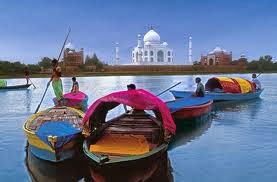Although I cannot say exactly when my love for India began, I can say there will always be a special place in my heart for it. My friend since age 14, Shamim, was my first exposure to Indian culture. She was a first generation Indian, her parents immigrants from the Western State of Gujarat. I have very fond memories of spending evenings with Shamim and her sister Shirin playing trivial pursuit in their home while their sweet mother served us her famous Shami Kebabs and Biryani. I was instantly hooked! Once I tried the lovely fragrant food of India, almost everything else tasted bland. I had never been exposed to such unique flavors. Later as a software engineer at Verizon, I had the opportunity to work with many native Indians from all over the country. I was amazed at how much variety existed in Indian cuisine depending on the region.
For example, the northern states of India who were heavily influenced by the Moguls use meat far more than the majority vegetarian dishes of the south. They also use breads such as Naan, Chapatis, and Parathas in the North, while the south utilizes rice as their staple. The western state of Gujarat is known for its vegetarian daals(lentils), while the eastern state of Bengal's cuisine is famous for its fish, rice dishes as well as their sweets! I was so fortunate to learn first hand from my colleagues how to prepare authentic Indian Food. I will never forget what my dear friend Amit taught me about the "Holy Trinity" of Indian Food. Pyaj, Adarak, and Hari Mirch-Onion, Ginger, and Green Chiles. However, he said the most important ingredient when cooking Indian food is love. So true!
Today, India is the largest democracy with a population of over 1.2 Billion people. So where did all of these people come from? The first major immigration to India was by the Aryans, tall fair people who came from the Caspian Sea around 1500 B.C. They came through the Himalayas in seek of better pastures for their cattle. After many years, they became integrated with the Dravidians from the South, known for their smaller stature and darker features. Thus began the Indian people as we know it.
India has been influenced by many outside cultures as well. The Macedonian Conqueror and Explorer Alexander the Great arrived around 325 B.C. Hinduism was widely practiced in the land and later came Buddhism. In the first century St. Thomas himself brought Christianity as a missionary. In the 5th century, the Huns invaded, and in the 12th, the Mogul Emperors. In the 18th Century, the British arrived and became Colonial rulers. They raped, robbed, and pillaged their way through India for two hundred years. Currently 80% of India's population are Hindu, 14% Muslim, 2% Christian, 2% Sikh, 1% Buddhist, and 0.4% Jain.
1947 signaled the end of British rule when British India was divided into two states, India and Pakistan. The Punjab and Bengal were split between the two countries. This meant that millions of Hindus, Muslims and Sikhs who had shared neighborhoods for generations, suddenly found themselves on the wrong side of the newly created borders.
As many celebrated independence, over 14 million people attempted to cross hastily drawn borders in what became the largest migration in history. Hindus and Sikhs fled to India, and Muslims to Pakistan. The Grand Trunk Road and the railway built alongside it, became the major routes along which millions of refugees travelled. They were also the scenes of some of the worst violence - in the Punjab alone, hundreds of thousands of people were murdered. Vast refugee camps sprung up along the road as people gathered together for protection, or found themselves homeless in a new country. Relations between India and Pakistan have remained tense ever since.
The Flag of India has three colors-Saffron, White, and Green. The saffron color represents courage and sacrifice; white – truth, peace and purity; green – prosperity; and the Ashok Chakra in the center of the flag represents the Laws of Dharma, righteousness.
There are so many festivals celebrated in India. From the Hindu Spring festival Holi-the festival of colors which celebrates good over evil, to the Muslim festival of Eid ul Fitr celebratory day that generates the deep devotion and surrender to Allah during Ramadan. It refers to the breaking of the month-long routine of fasting from sunrise to sunset. 'Eid' itself implies a 'festive' occasion that spreads joy and happiness all around.














I enjoy reading the background information about the customs, culture and cuisine but especially the first hand personal experience you have had with all these wonderful people!
ReplyDelete